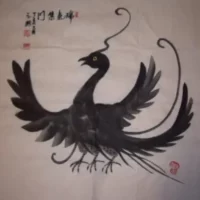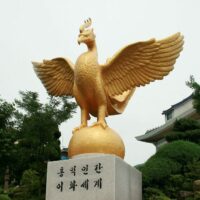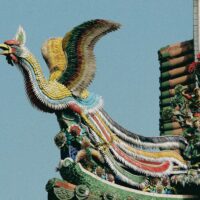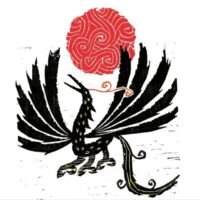Samjoko : The Three Legged Crow
Listen
At a glance
| Description | |
|---|---|
| Origin | Korean Mythology |
| Classification | Animals |
| Family Members | N/A |
| Region | South Korea |
| Associated With | Sun |
Samjoko
Introduction
In the landscape of Korean mythology, the Samjoko (삼족오) occupies a radiant spot as a powerful solar symbol, deeply entwined with ancient royal authority and cosmological harmony. Unlike the dragons or phoenixes that frequently dominate East Asian folklore, the Samjoko is unique—its identity rooted not just in majestic appearances but also in its cosmic function. Originating in the ancient kingdom of Goguryeo, this legendary three-legged crow was more than a creature of myth; it was regarded as a guiding force of the sun and a celestial companion of sovereign power. Revered as a divine embodiment of light and unity, Samjoko became a central figure in Korea’s visual and spiritual legacy.
Physical Traits
Samjoko is distinguished by its striking and enigmatic appearance: a large black crow with three legs. This trio of limbs is more than a physical anomaly; it is symbolic of the eternal cosmic principles of Heaven, Earth, and Humanity. In ancient Goguryeo murals, the creature often appears encircled by a blazing sun, glowing with an inner light that reinforces its association with the solar deity. The black color of its feathers does not denote darkness but instead suggests the mystery and power of the universe. The creature’s form radiates a majestic energy that makes it more than a mere bird—it becomes an emblem of time, continuity, and balance.
In artistic interpretations over time, especially in modern depictions, Samjoko is sometimes given a supernatural quality. Its wings may shimmer with gold or scarlet hues to reflect the sun’s intensity, and its eyes are imagined to hold prophetic clarity. Despite these creative liberties, the consistent core of the myth is its symbolic dominion over the sun’s cycle and divine authority.
Family
Unlike many mythological beings with elaborate genealogies, Samjoko is generally treated as a singular, standalone entity rather than part of a pantheon or familial lineage. It doesn’t trace its roots through gods or ancestral spirits in the way that dragons or demigods might. However, its spiritual role suggests a symbolic relationship to divine figures such as Haemosu, the sun-god figure in Korean lore, who is often linked with solar motifs and celestial birthrights.
This symbolic connection aligns Samjoko with mythic figures that bridge the heavens and the earth. While not portrayed as offspring or consort in traditional stories, Samjoko functions as a divine extension of the cosmic order—present in the sun, interacting with human realms, and carrying with it the authority of the divine. It is this role that defines its standing in mythology, rather than any explicit family ties.
Other names
The concept of a three-legged crow is not exclusive to Korea, and the Samjoko shares thematic parallels with similar creatures in East Asian mythology. In China, the Sanzuwu represents the sun and appears in classical texts as a solar bird that lives within the sun. In Japan, the Yatagarasu plays the role of a divine guide, famously aiding Emperor Jimmu on his journey to unify Japan. Each of these cultural equivalents emphasizes the bird’s connection to divine intervention and celestial navigation.
While Samjoko is the Korean name, its legend has extended into other regions and languages. In Tagalog, it’s referenced as the “crow with three legs,” and in European interpretations, adapted names like Samjogue and Sanjoco appear in niche scholarly discussions. Across these names and contexts, the consistent element is the three-legged design and its association with cosmic guidance and the sun’s omnipresent eye.
Powers and Abilities
Samjoko’s significance lies not in physical prowess but in its celestial responsibilities and symbolic authority. As the creature believed to reside within or guide the sun, it commands power over time, light, and seasonal cycles. In Goguryeo belief systems, Samjoko was seen as a guardian of kings, illuminating the path of righteous rule and aligning governance with heavenly will.
The crow’s presence on royal garments, artifacts, and state banners symbolized its power to legitimize and protect. This alignment between ruler and solar deity conveyed the idea that kings ruled not merely by bloodline, but with cosmic approval. Its presence was thus an assurance of divine order and an anchor for political stability.
Some modern reinterpretations grant Samjoko additional abilities such as emitting healing light, casting divine judgment, or using solar energy to ward off evil. These interpretations, while speculative, remain grounded in the creature’s original associations with illumination, clarity, and celestial protection. The number of legs—three—continues to symbolize universal stability, echoing the balance of time: past, present, and future.
Modern Day Influence
Despite its ancient roots, Samjoko has not faded into obscurity. Instead, it has undergone a cultural revival in contemporary Korea, serving as a symbol of national pride and identity. When discussions emerged in 2008 around replacing the phoenix in Korea’s national seal, Samjoko was a strong contender, representing sovereignty and the deep roots of Korean heritage.
In sports culture, Samjoko’s image is proudly displayed by Jeonbuk Hyundai Motors FC, illustrating its embodiment of strength, unity, and tradition. This adoption of an ancient symbol in modern competitive arenas shows how myth continues to inspire collective spirit and pride.
The bird also makes regular appearances in media and pop culture. Historical dramas like Jumong reintroduce the legend to mainstream audiences, reinforcing its mythic status. Artists frequently incorporate Samjoko into tattoos, illustrations, and digital art, tapping into its mysticism and historical gravitas. It even appears in corporate branding, especially among companies aiming to project innovation grounded in heritage.
In education and heritage preservation, Samjoko features prominently in museums and cultural exhibits that explore the art and mythology of the Three Kingdoms period. Through these platforms, young generations learn about the symbolic value of ancient mythology and how it reflects Korean values of balance, strength, and celestial connection.
Related Images
Source
Byeon, M. (2024, October 20). The Sacred Three-Legged Crow: Goguryeo’s Mythical Symbol of Power. K-POP TIMES. https://byeon.com/traditional-korean-patterns-4/
goddessRhoda. (n.d.). Korean Mythology – Samjoko. Wattpad. https://www.wattpad.com/723277751-korean-mythology-samjoko
Dunbar, J. (n.d.). Creatures of Korean Mythology. The Korea Blog. https://mythology.guru/creatures-korean-mythology/
Ognimdo2002. (2021, May 14). Samjoko. DeviantArt. https://www.deviantart.com/ognimdo2002/art/Samjoko-879479283
Vienneau, L. (2016, August). Sanzuwu, Yatagarasu, and Samjok-o – The Three Legged Crow. Larry Vienneau Prints. https://larryvienneauprints.blogspot.com/2016/08/sanzuwu-yatagarasu-and-samjok-o-three.html
Dunbar, J. (2011, December 18). Supernatural Creatures of Korean Mythology. Korea Lablob.
Frequently Asked Questions
What is lorem Ipsum?
I am text block. Click edit button to change this text. Lorem ipsum dolor sit amet, consectetur adipiscing elit. Ut elit tellus, luctus nec ullamcorper mattis, pulvinar dapibus leo.
What is lorem Ipsum?
I am text block. Click edit button to change this text. Lorem ipsum dolor sit amet, consectetur adipiscing elit. Ut elit tellus, luctus nec ullamcorper mattis, pulvinar dapibus leo.
What is lorem Ipsum?
I am text block. Click edit button to change this text. Lorem ipsum dolor sit amet, consectetur adipiscing elit. Ut elit tellus, luctus nec ullamcorper mattis, pulvinar dapibus leo.
What is lorem Ipsum?
I am text block. Click edit button to change this text. Lorem ipsum dolor sit amet, consectetur adipiscing elit. Ut elit tellus, luctus nec ullamcorper mattis, pulvinar dapibus leo.
What is lorem Ipsum?
I am text block. Click edit button to change this text. Lorem ipsum dolor sit amet, consectetur adipiscing elit. Ut elit tellus, luctus nec ullamcorper mattis, pulvinar dapibus leo.










